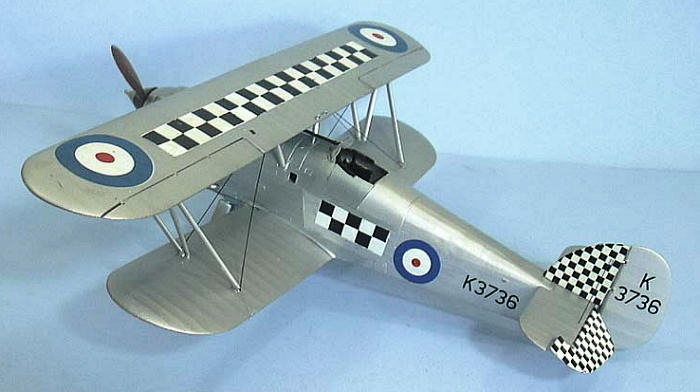
Montex 1/32 Hawker Fury I
| KIT #: | 3203 |
| PRICE: | @$160.00 MSRP |
| DECALS: | Two options |
| REVIEWER: | Tom Cleaver |
| NOTES: | Resin multimedia kit |

| HISTORY |
Following the end of the First World War, British fighter design went into a
decade-long doldrums, in which the performance of those fighters which were
designed and built was merely incremental over the performance of the airplanes
which won the war in the air over the Western Front in 1918.
The appearance of the Fairey Fox in 1926, with a speed only a few miles per hour
less than those of the defending fighters, was the harbinger of change.
The Fox was followed in 1927 when Sydney Camm, Hawkers’
Chief Designer, developed what became the Hawker Hart, a two-seater in the
tradition of the deHavilland D.H.4, with a top speed of 184 m.p.h.
Given that the Bristol Bulldog, then the most-advanced
RAF fighter and not yet in service, had a top speed of only 174 m.p.h.,
something had to be done.
RAF specification F.20/27 required that the winning design have the ability “to
overtake, in the shortest possible time, an enemy aircraft passing overhead at
20,000 feet and 150 m.p.h.”
Camm went all out with his design.
It used the then-new Hawker techniques of metal
construction, which lowered the overall weight.
The result was a small, single-bay biplane that was
marred - in Camm’s view - by the official insistence on the use of the Bristol
Mercury radial.
Rolls-Royce was developing the F.IX liquid-cooled inline engine -
which would soon be known as the Kestrel - which promised a far bett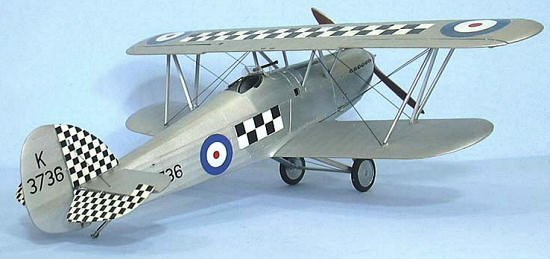 er
weight-to-power ratio, not to mention the opportunity to streamline the fuselage
of the F.20/27 and increase its speed.
er
weight-to-power ratio, not to mention the opportunity to streamline the fuselage
of the F.20/27 and increase its speed.
At a time when the economics of aviation were terrible, when companies like
Hawkers were barely hanging on with orders for 20-30 aircraft at a time, Camm
convinced the Board of Directors to authorize a private-venture prototype, to be
powered by the Rolls-Royce engine, based on the F.20/27 airframe.
The result was called the “Hornet,” and all of Camm’s
predictions regarding overall performance were proven accurate.
The F.20/27 was ordered in 1928, and the resulting airplane - powered by a
Jupiter VII pending availability of the Mercury - had a top speed of 190 m.p.h.,
which was not enough to allow it to climb to altitude as an interceptor and then
give chase to an enemy aircraft with the performance of the Hart.
Powered by an uncowled Mercury in 1930, the F.20/27 gave
a creditable performance of a top speed of 202 m.p.h. but by this time all
attention was on the private-venture Hornet.
Carrying roundels but no serial number, the private-venture Hornet made its
first flight at Brooklands in March 1929, flown by George Bulman, fitted with
the 420 h.p. F.IXA. Exhibited later that summer at the Olympia Aero Show, the
“Hornet” caused a sensation with its fine lines and outstanding performance.
Shortly after, it was given a 480 h.p. F.IXS engine.
In November 1929, it was tested at the A&AEE, following
its purchase by the Air Ministry and assignment of serial J9862.
Official tests revealed a top speed of 205 m.p.h. at
13,000 feet, and an ability to climb to 10,000 feet in 5 minutes,9 seconds.
The Air Ministry relieved itself of the irony that the recently-introduced Hart
bomber was 13 m.p.h. faster than the brand-new Bristol Bulldog by announcing an
order for 21 F.13/30 fighters, the specification having been written around the
Hornet.
The first of what was now known as the Fury flew on March 25, 1931, and
all 21 were delivered by April 15.
By the end of May, 43 Squadron had re-equipped with 16
Furies, and a flight of three gave a memorable aerobatic performance
during the 1931 RAF Display at Farnborough.
Later that year, 43 Squadron proved the Fury in its role
of interceptor during the Annual Air Defense Exercises, making more successful
interceptions than all other squadrons combined.
48 more Furies had been ordered in la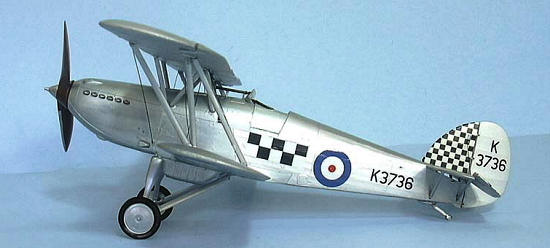 te
1930, which were constructed in the latter part of 1931.
25 Squadron began to re-equip in January 1932, followed
shortly by 1 Squadron.
In the following years, 25 Squadron would provide
memorable performances at air shows with three Furies “tied together” by an
elastic rope.
1 Squadron worked up a routine which involved formation changing
in front of the crowd for the first time, which fully demonstrated the Fury’s
performance and controllability.
te
1930, which were constructed in the latter part of 1931.
25 Squadron began to re-equip in January 1932, followed
shortly by 1 Squadron.
In the following years, 25 Squadron would provide
memorable performances at air shows with three Furies “tied together” by an
elastic rope.
1 Squadron worked up a routine which involved formation changing
in front of the crowd for the first time, which fully demonstrated the Fury’s
performance and controllability.
Three more production contracts, for 16, 13, and 20 aircraft - for a total of 48
- were made during 1933-35.
These aircraft were mainly used as attrition
replacements for the three Fury-equipped squadrons.
The Fury Mk.II appeared in 1936, as a result of incremental changes that had
been initiated by Hawkers starting in 1932.
Primarily dinstinguishable from the earlier Fury Mk.I by
its use of streamlined “spats” on the main wheels, an initial batch of 23 were
ordered in 1936, with an additional order for 89 later that year as a stopgap
pending the arrival of the Hurricane and Spitfire, both of which were
experiencing delays in development. With Hawkers completely involved in
developing the Hurricane, these aircraft were all produced by General Aircraft,
Ltd., and were delivered by the end of 1937.
Many of these were quickly passed on to the Flying
Training Schools as advanced trainers, where they would serve into the early
years of the Second World War.
The stark unpreparedness of the RAF for a modern war was demonstrated in the
fall of 1938 when the Furies and the rest of the RAF’s frontline fighters - all
biplanes - hurriedly traded in their colorful prewar liveries for drab
camouflage as the Munich Crisis and possible war over the Sudetenland loomed.
Not one of the British types would have been a match for
the German Bf-109 (though no one knew at the time that this fighter was in far
more limited operational use than German propaganda had indicated).
Even the Furies, however, would have given a good
account of themselves against the Heinkel He-51 and Arado Ar-68 which equipped
the majority of the Jagdwaffe.
While the Fury left front-line RAF service in the months following the Munich
Crisis in 1938, the airplane would yet see combat in the coming war.
In 1935, seven Furies were ordered by the South African
Air Force, marking the first single-seat fighters to be used by that service
since 22 S.E.5a fighters were provided by the Imperial Gift in 1920.
When 1 Squadron moved north in May 1940 for operations against the Italians in
east Africa, six Furies were part of the unit’s equipment.
Arriving in Mombasa in June 1940, six ex-RAF Fury Is
were added to their equipment that August, with 16 more
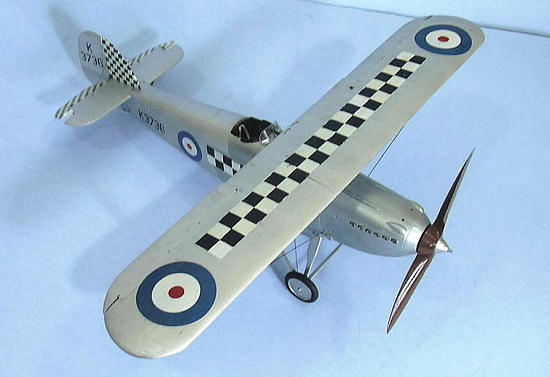 arriving
between October and January 1941.
On October 27, 1940, the Furies first saw combat when
four Italian Ca.133s from 8 Gruppo, 25 Squadriglia, attacked their airfield.
Of three Furies scrambled, one failed to start and the
guns of the second jammed; Flight Lieutenant Blake attacked the Italian bombers
alone, shooting down one after a series of head-on attacks.
A second attack on October 29 by three Ca.133s saw one
shot down by a defending Fury I. During October, 2 Squadron was formed out of 1
Squadron, with 9 Furies.
On October 31, two Furies from this unit came close to
shooting down two SAAF Ju-86s carrying General Jan Smuts, Sir Pierre van
Ryneveld, Major General Alan Cunningham, and major General Galmen-Austen.
The aircraft had not followed proper identification
procedures, and one Fury fired at and hit the Ju-86 carrying General Smuts
before identification was made at the last moment.
arriving
between October and January 1941.
On October 27, 1940, the Furies first saw combat when
four Italian Ca.133s from 8 Gruppo, 25 Squadriglia, attacked their airfield.
Of three Furies scrambled, one failed to start and the
guns of the second jammed; Flight Lieutenant Blake attacked the Italian bombers
alone, shooting down one after a series of head-on attacks.
A second attack on October 29 by three Ca.133s saw one
shot down by a defending Fury I. During October, 2 Squadron was formed out of 1
Squadron, with 9 Furies.
On October 31, two Furies from this unit came close to
shooting down two SAAF Ju-86s carrying General Jan Smuts, Sir Pierre van
Ryneveld, Major General Alan Cunningham, and major General Galmen-Austen.
The aircraft had not followed proper identification
procedures, and one Fury fired at and hit the Ju-86 carrying General Smuts
before identification was made at the last moment.
The Furies remained in East Africa until April 1941 without seeing further
combat, and were then returned to South Africa, where they were operated as
advanced trainers in the Empire Air Training Scheme and provided air displays
around the country for recruitment.
Hawkers had demonstrated the Hornet prototype to possible foreign customers in
1930.
In 1932, the Yugoslav Air Force ordered six Furies, which were delivered
later that year. Ten more were ordered in 1935, powered by the Kestrel XVI and
featuring cantilever undercarriages with Dowty internally-sprung wheels.
Domestic production in Yugoslavia eventually produced 40
more Furies which were delivered by the end of 1937, 24 from Ikarus and 16 from
Zmaj. By the middle of March, 1941, attrition had brought the number of
serviceable Furies down to 30, which had been assigned to the 34th
Fighter Group of the 4th Fighter
Regiment in Zagreb and the 35th
Fighter Group of the 5th Regiment
on the Bulgarian border as Hurricanes and Ikarus IK-2s replaced them.
Throughout the month of March, the Furies attempted
without success to intercept Luftwaffe reconnaissance aircraft overflying
Yugoslav territory.
The German attack on April 6 was opposed by the Furies as well as they could,
though they were outperformed by the Bf-109Es flown by the Luftwaffe.
The 35th
Fighter Group
retreated in the face of enemy ground onslaughts between April
9-13, finally ending up at Sarajevo before heading into Montenegro where the
survivors were burned on the field at Niksic on April 15.
The 36th
Group was almost completely destroyed on the ground in the opening attacks on
April 6, and never fully participated in the battle, though there is an
unconfirmed report that one pilot of this unit downed a strafing Bf-109E by
ramming it.
In total, the
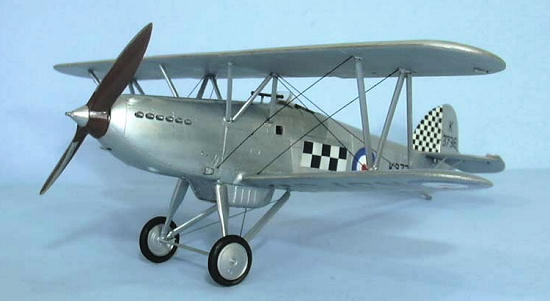 Furies of
the 35th Group claimed 15
victories, including three Bf-109s and a Bf-110, a very creditable performance,
given the qualitative differences between the adversaries and the war situation.
Furies of
the 35th Group claimed 15
victories, including three Bf-109s and a Bf-110, a very creditable performance,
given the qualitative differences between the adversaries and the war situation.
The Fury was also ordered by the Spanish Republic in 1935.
These were to be powered by the Hispano-Suiza 12Xbv
engine and to have landing gear similar to that of the second batch of Yugoslav
Furies.
By the outbreak of the fascist rebellion in June 1936, three Furies had
been delivered, to be used as pattern aircraft for domestic production by
Hispano-Suiza in Guadalajara. The three Furies were assembled at the outbreak of
the civil war and flown without armament on morale-building missions over
Madrid.
By mid-August, the Furies were armed, but the gun synchronization system
was not properly set.
When one of the Furies came across the
Patrulla Azul - three Fiat C.R.32s led by Gabriel
Garcia Morato - the pilot promptly shot off his own propeller when he opened
fire; the crashed airplane was paraded by the Nationalists in Badajoz. In
October, a second Fury was shot down by the Patrulla Azul, while the third
crashed due to bad weather.
That November, the Republicans collected the parts of
these two crashed Furies and constructed on from the remains.
This was later captured by the Nationalists, who had
rebuilt Fury 4-2, and both were used for propaganda purposes and survived in the
Nationalist Air Force until the early 1940s.
While the legend of the “barrier-breaking Fury” (it being the first fighter to exceed the “200 m.p.h. barrier”) was more a case of public relations, the fact is that the airplane did represent a significant advance in construction and powerplant, and directly led the way to the Hurricane - which was first known at Hawkers as “the Fury monoplane.” It is still one of the most beautiful aircraft designs of its era.
| THE KIT |
The Fury is the third release from Montex, and is done as the Fury Mk.I for kit
3203 and the Fury Mk.II for kit 3204.
These differ primarily in provision of markings and
spats for the wheels on the Mk.II.
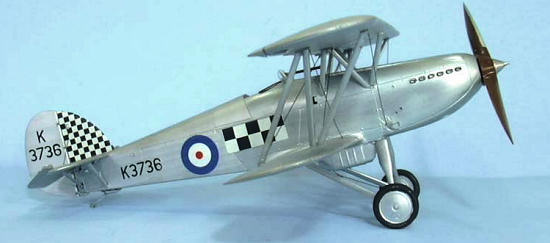 The parts are finely-molded resin, with superb surface detail.
In fact, this is some of the best fabric-surface detail
I have seen in any kit.
The cockpit structure is supplied so completely that
there are parts which cannot be seen when the work is completed and the fuselage
assembled.
All the parts are flash-free and the kit approaches the molding
quality of an injection-molded kit.
The parts are finely-molded resin, with superb surface detail.
In fact, this is some of the best fabric-surface detail
I have seen in any kit.
The cockpit structure is supplied so completely that
there are parts which cannot be seen when the work is completed and the fuselage
assembled.
All the parts are flash-free and the kit approaches the molding
quality of an injection-molded kit.
Masks are provided for the national markings. Unfortunately, the masks for the national insignia are too big for those used on the Fury. Markings are provided for a Flight Leader’s airplane of 1 Squadron in 1932, and an advanced trainer used in 1939. Unfortunately, the squadron insignia for 1 Squadron is also incorrect, though a determined modeler could modify these masks to get the markings if they so desired.
| CONSTRUCTION |
Construction is straightforward if one ponders the instructions long enough to
make sense of them, since there is some vagueness in the illustrations.
Unfortunately, there are no in-progress shots for you to
look at.
This is because halfway through the project, I discovered an immediate
need to undergo a computer upgrade (“Your computer doesn’t work any more sir,
you need a new one.”), with the result that the new operating system would not
read the old flash card, so that all unprocessed shots (which, naturally,
included these) are “out there somewhere,” but not where you or I can see them.
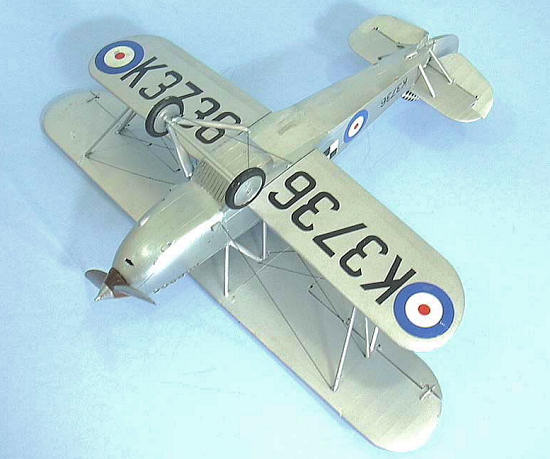 I
began by painting the cockpit parts before assembly.
The Fury Mk.I had the old-style painting as follows: the
inner fabric surfaces were brick red, for which I used Gunze-Sangyo “Rot 23"
red; the inner aluminum surfaces were light grey, for which I used Xtracrylix
“Light Aircraft Grey.”
The frame structure was “japanned”, for which I used
Tamiya “Semi-Gloss Black;” the seat was unpainted aluminum, for which I used
Tamiya “Flat Aluminum,” and the wooden bulkhead immediately behind the seat was
varnished natural wood, which I hand-painted to give “wood effect.”
I
began by painting the cockpit parts before assembly.
The Fury Mk.I had the old-style painting as follows: the
inner fabric surfaces were brick red, for which I used Gunze-Sangyo “Rot 23"
red; the inner aluminum surfaces were light grey, for which I used Xtracrylix
“Light Aircraft Grey.”
The frame structure was “japanned”, for which I used
Tamiya “Semi-Gloss Black;” the seat was unpainted aluminum, for which I used
Tamiya “Flat Aluminum,” and the wooden bulkhead immediately behind the seat was
varnished natural wood, which I hand-painted to give “wood effect.”
Assembly of the cockpit was as straightforward as it gets when one is using
cyanoacrylate glue.
I used Eduard’s 1/32 Sutton harness set, which was the
one thing not provided in the kit.
Once assembled, the cockpit fit in the fuselage without
problems.
However, when I attached the other fuselage half, I saw that
there was enough of a gap between the cockpit frame and the fuselage half that
it would be very noticeable if I assembled the cockpit entry flap open.
I decided to close it, since the Fury looks best “zipped
up,” and it was still possible to see the cockpit.
With the fuselage assembled, I attached the radiator, and turned to the wings
and tail.
I assembled the horizontal stabilizer with the elevators drooped,
and the vertical fin with the rudder “kicked” slightly to the right.
The three part upper wing went together with no problem.
At this point, I stopped to paint the model.
| COLORS & MARKINGS |
Painting:
When I first realized the problem with the markings masks, my first thought was
to paint the model as one of the 43 Squadron Furies during the Munich Crisis, in
Dark Earth and Dark Green upper camouflage and black/white/aluminum lower
surfaces, since that way I would only need two Type-B roundels for decals.
However, as I looked through the decal dungeon, I
discovered I had a Blue Max sheet of British Roundels that provided six of the
proper size for the Fury.
I also had some old sheets of black checkerboards and a
sheet of solid white, which would allow me to do the markings for 43 Squadron.
With this in hand, I decided to do the “classic” scheme.
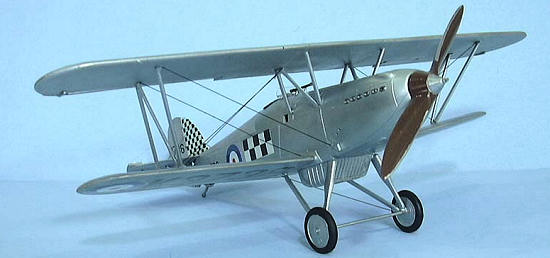 I
first gave the model an overall coat of Tamiya “Flat Aluminum.”
When this was dry, I applied a coat of Talon “Platinum”
over the fabric surfaces.
I then masked that off and painted the metal areas with
Talon “Dark Aluminum.”
When that was just shy of being fully dry, I applied the
SnJ polishing powder and polished out the cowling and radiator.
I
first gave the model an overall coat of Tamiya “Flat Aluminum.”
When this was dry, I applied a coat of Talon “Platinum”
over the fabric surfaces.
I then masked that off and painted the metal areas with
Talon “Dark Aluminum.”
When that was just shy of being fully dry, I applied the
SnJ polishing powder and polished out the cowling and radiator.
Decals:
I
didn’t have any decals that could substitute for the masks.
Fortunately, these were the correct sizes.
I used the serial number for the trainer, since it had
been passed on from an operational squadron.
The resulting model is not “factual” in terms of actual
photographic evidence that this airplane with this serial number was ever flown
by the Squadron Leader of 43 Squadron, but it is done as an airplane that could
have been a replacement for an original Fury with the striped rudder, supplied
to 43 Squadron around 1936-37, when the rudder stripes had been dropped.
The serial number masks were done first, and worked like a charm over the aluminum paint. With that done, I moved on to the decals. The roundels presented no difficulties. I then cut the checkerboards to fit their respective locations; the largest are on the upper wing, with those on the fuselage slightly smaller in dimension, with those on the tail the smallest. I then cut correctly-sized and shaped backing from the white decal sheet. Once that was applied and set, the checkerboards were applied.
| FINAL CONSTRUCTION |
I
attached the landing gear and the tail assemblies with no trouble and then
turned to the wings.
The lower wings were attached without problems, and it
was now time to figure out the struts.
Here is where things got difficult.
The cabane struts and the interplane struts are made of
white metal, and they need to be cut to the proper dimensions to make the
respective “N” struts.
I think if I had any Contrail plastic strut strips left,
I would have used them even though they might have been a bit weak for a model
this size.
As it was, the operation was done with photos of the Fury and a
small 3-view drawing in Air Enthusiast Quarterly No. 3,
a Mark 1 eyeball, a razor saw, and cyanoacrylate glue.
The air over the workbench only turned a light magenta
during the day-long process, with the end result looking as close to photos as I
could get it.
If Montex releases any more Furies (there are the Spanish and
Yugo Furies and the Nimrod as possibilities), I sincerely hope Daryl molds the
N-struts in one piece resin, perhaps with wire inside for strength.
After all that, the wire bracing was done with .010 brass wire painted black.
I decided (for now) to take a pass on assembling the
radio antennas.
| CONCLUSIONS |
Montex’ Hawker Fury is definitely the most accurate kit made of this beautiful
airplane and results in a beautiful model.
Unfortunately, the same cannot be said for the old Merit
kit or the Airfix kit in 1/48.
There was a 1/72 Fury made long, long ago, the
manufacturer of which I do not recall, but it was also not dimensionally or
outline accurate (Tom is probably commenting on the Matchbox and Aeroclub
kits. Ed).
Thus, if you are a serious fan of the Hawker Fury, then the $160
price of this kit is not too much to pay.
As they say about good movies, “every penny is up on the
screen.”
The quality of the kit is outstanding, with the design so good that any
modeler who has done at least one resin kit of any kind and at least a couple of
biplanes, should have no problem with the assembly.
Even the struts are not anything more than “some
modeling skill required.”
As to the problem with markings, the modeler who is
going to buy this kit likely has a big enough decal stash to solve the problem
of markings.
The result will definitely be worth the effort.
Thanks to Montex for the review kit.
February 2009
If you would like your product reviewed fairly and quickly, please contact me or see other details in the Note to Contributors.